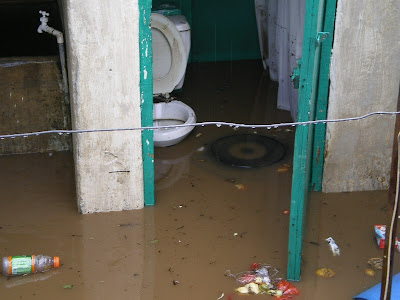This is what they do. This is what we do.
This is what we do. And that is how a well is dug.
And that is how a well is dug.
The well has been dug. The water is down there. Now we just have to finish up so we can get the water to where it will be useful. You know, not 320 feet deep in a hole.
A ‘caseta’ or small house (the literal translation from Spanish is hut) is being built to house the electrical panel for the connection to the pump. And Union Fenosa, the government entity that controls all things electrical in Nicaragua (or the lack thereof) is said to be close to giving us our permit for this work.
We have the first review of the houses completed and the architect is working on the revisions. Given that we started over with a new architect only three months ago who would actually work with us and the terrain that exists on the property, the progress has been astonishingly fast.

Clockwise starting with upper left corner: Lorena Zamora (our architect) and Gunther discuss sightlines, flowers on the finca, potential location for two personnel houses, my new rubber boots with skulls and crossbones and a whole lotta mud.
We’ve reroofed the existing building, added toilets and a shower, made extensive repairs and changes to the city water we receive (which is still too contaminated to drink) and generally gotten the site ready for the workers when they arrive to start construction.
But I am easily reminded as I glance around my office at paperwork for later stages of the project how much there is yet to do.
When we finish with this project we will have roads, walkways, a school, therapy offices, sport courts, a church, administrative offices, workshops, parks, an industrial kitchen, a dining hall, nearly 30 houses for 20 people each, a clinic, housing for visitors, housing for staff, housing for volunteers, store rooms, farmland, farm animals, drinking water, sewage treatment, electrical, phone and internet networks, all in the middle of a developing country. Phew!
When you think about all the resources needed to raise a child, the buildings, the materials, the caregivers (and all that the caregivers need as well) that is what we’re trying to plan for, only in our case, it’s 500 of them at the same time.






























